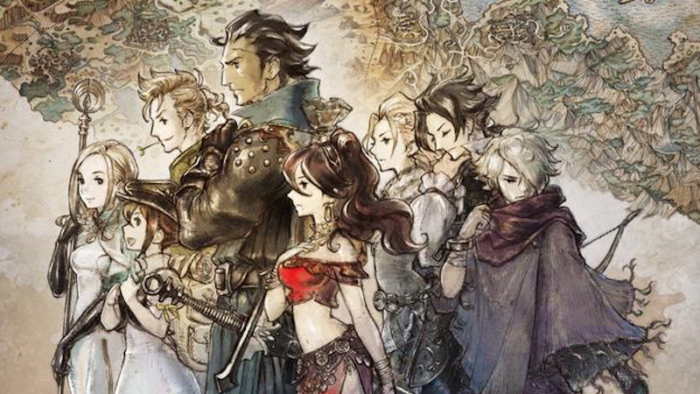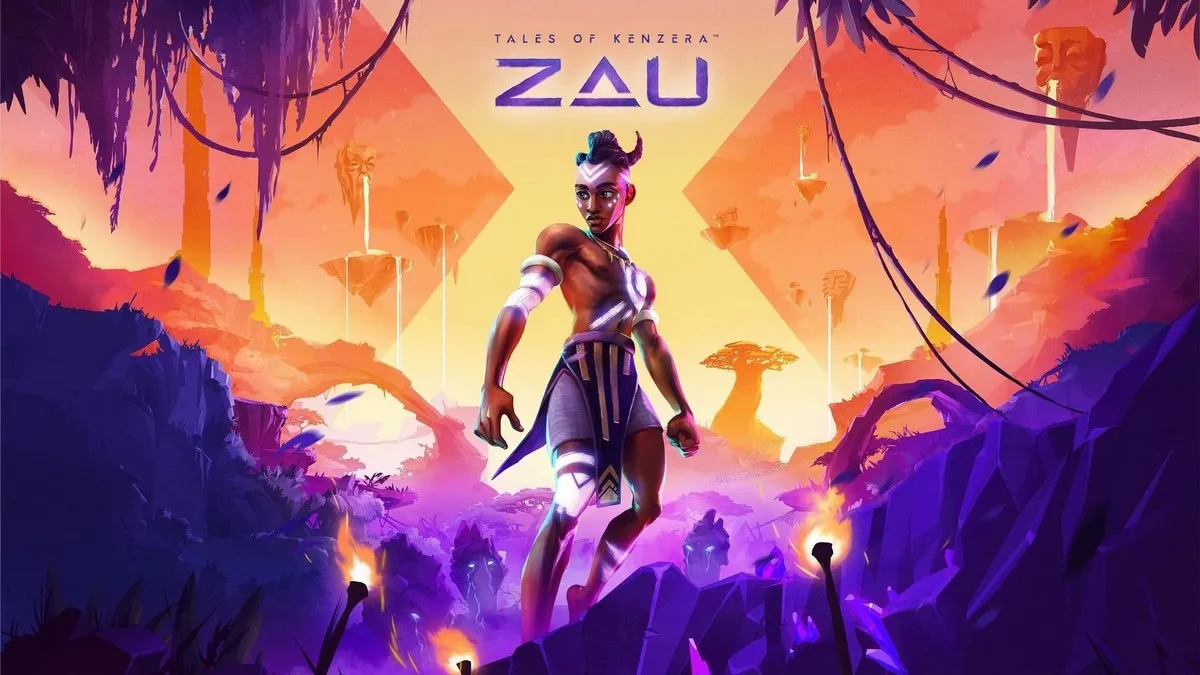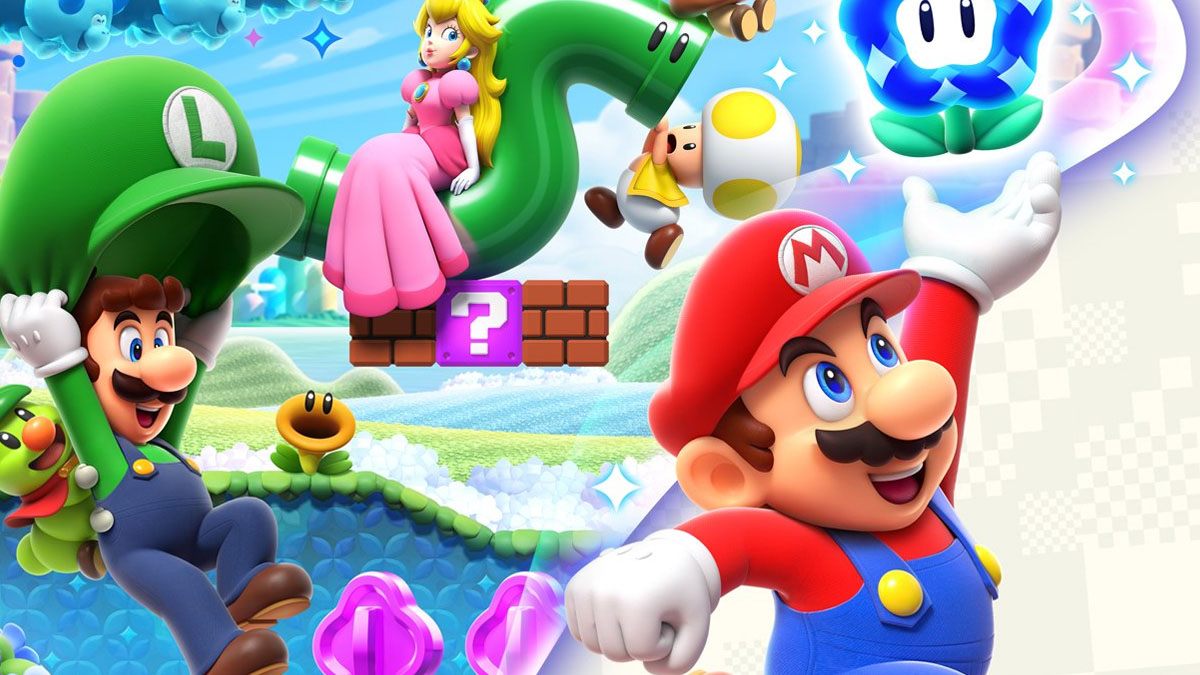Octopath Traveler on Switch
Octopath Traveler has rekindled a sense of fondness that I haven’t felt in JRPGs since I completed Persona 4 for the very first time. You know the feeling —that wonderful sentiment of adventure and mystery as you embark on a journey with a group of friends, resolving major problems together (maybe not so much “together” in this case, though), and finally being left with a bittersweet longing when everything comes to a close. And when you’ve got a killer soundtrack that hits all the right emotional beats to go along with it, you know you’ve got a winner here.
Developed by Square Enix and Acquire, Octopath Traveler is a classic JRPG in every sense of the word. The game features “HD 2D” sprites and backgrounds, with 3D-ish environments that blur out and fade into view as you move further away or closer to them. Octopath Traveler’s look is instantly captivating because of the cute sprites that call back to the SNES era, but with the polish of modern-day games when you notice the water glistening prettily in Rippletide. The game has this stunning dreamlike quality to it that reminds me of a pop-up book or a grandiose play that’s being presented through a diorama. To go along with the game’s gorgeous graphical style is the cast of eight characters, all of which come with unique story arcs that you can experience in one playthrough.
I’ll get this out of the way quickly since I know it’s the biggest thing that’s weighing on everyone’s minds pre-release. Octopath Traveler allows you to play as all of the eight characters, and you get to pick a main protagonist at the very start. As far as I could tell, your choice of protagonist doesn’t actually affect how the narrative plays out, and you’ll still get to experience everyone else’s full stories. However, your protagonist is locked into your party until you play their story to the very end. Each character gets four story chapters, so unless you choose to grind levels on your main character before playing around with the rest of the cast (which I don’t recommend doing), you’re pretty much stuck with them for the whole game. With that in mind, you’re probably gonna want to pick your favorite out of the eight to start with.
All of the eight-story arcs are entirely separate from each other. They all have beginnings, middles, and ends. There are recurring themes and references in the stories as you get into the later chapters, but if you’re hoping for some grand quest where the party suddenly bands together and works towards a common goal like in most JRPGs, there’s nothing like that here. It’s best to look at the game as an anthology or a collection of personal stories from eight different travelers. And this is where Octopath Traveler’s narrative structure starts to fall apart a little.
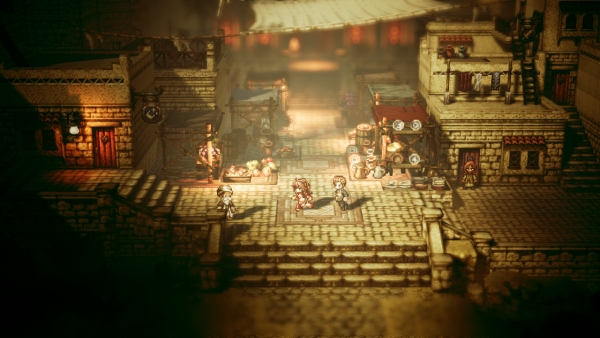
Let’s start with the game’s eight chapter 1s. Once you’ve picked your protagonist and completed their first chapter, you’ll see a location marker on your map that indicates where you need to go for their chapter 2. However, the level recommendation will most likely be too high for you to attempt right away, and the game clearly intends for you to go recruit the other seven characters and clear their first chapters before you get started on the chapter 2 content. The main issue with this structure is that chapter 1 can feel repetitive. While most of the origin stories are very well-written and engaging, having to go through what is essentially the beginning roots of a JRPG seven times over can feel like a slog. From a narrative standpoint, it actually makes very little sense for some of these characters to be in a party, too. Like, why would Ophilia, who’s going on a sacred pilgrimage and visiting churches around the world, decide to help some thief break into a manor and steal their stuff? Octopath Traveler requires some degree of suspension of disbelief, and this is especially apparent as you progress through the stories.
For example, once you have a full party and you start going into chapter 2 content, the story segments play out like the rest of the party isn’t around. A character could get ambushed and beaten up in the streets, and your other seven characters wouldn’t show up to help because, well, it’s that specific character’s story, and the game acts like they’re alone in this. Simply put, when you’re playing through a character’s chapter, the rest of your party basically act as silent allies who just help you out in the fight itself. You’ll get used to it as you progress, but it’s pretty damn jarring at the start of the game and it really breaks any sense of immersion the game had going for it.
Thankfully, though, the stories themselves are actually really well-done. Despite the relatively simple starts for each character, the entire cast grows and develops over the course of the game. While some characters might appear naive during their first chapters, there’s a solid sense of character progression as they’re faced with new challenges, and are forced out of their comfort zones to overcome them. Tressa, for instance, ends up having an incredibly heartwarming journey despite her somewhat lackluster and trope-y start of just wanting to see the world. Some stories are far more engaging than others (shout out to my main, Primrose, for having the best story), but I found myself invested in all eight stories and wanting to see them through to the end. Even H’aanit, who completely put me off with her olde English, and the stoic knight Olberic eventually wormed their way into my cold, unfeeling heart.
From chapter 2 onward, the characters will also start interacting with each other in short bursts. Depending on who you have in your active party, you might receive a prompt to hear some travel banter between two characters about what’s currently happening in their story. These are pretty short and are presented in a style similar to the optional skits we have in the Tales series. It’s definitely a little disappointing to discover that character interactions are so limited, but they did start to appear a little more frequently in the final chapters, and even after you’ve completed all eight stories. In the post-game phase, I started to see interactions between three or four characters instead of two, and it’s nice when the cast plays off one another. It’s endearing, and I can’t help but wish Square Enix had taken the extra step to flesh them out further and provide more substantial interactions.
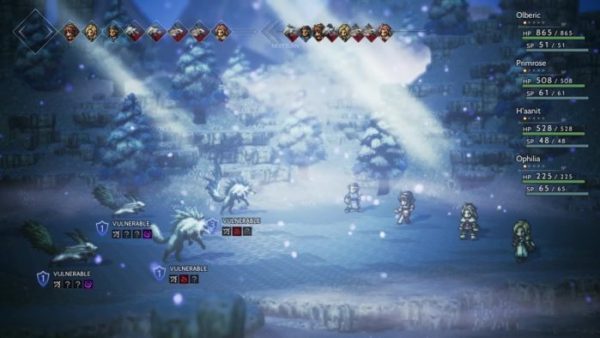
Every chapter follows the same structure, where you’d arrive at a town, watch a cutscene, go through a dungeon and defeat a boss, then watch another cutscene before moving on. As far as difficulty goes, the curve is smooth for the most part, though things do start to ramp up in chapter 2. This is around the point where you’ll start unlocking secondary classes to round out your party a bit more and give them a bit of versatility. As the bosses start to get tougher, managing your party and their classes becomes crucial. While I did manage to clear the chapter 2 bosses without too much trouble, the game starts to punish you for not organizing your party properly in the latter two chapters. There were times where I straight up had to rebuild my party with different secondary classes that were more optimal for them in that specific situation.
Along with managing secondary classes, Octopath Traveler’s boost system is also extremely important in turn management. Most boss fights will reach a point where your opponent charges up and gets ready for a devastating attack during their next turn. When this happens, you basically only have one turn to either shore up your defenses —which can be tough to do— or start expending all your boost points (BP) to break their shield and prevent them from attacking. The game’s combat system allows you to save up BP during each turn, and then expend them to attack multiple times or unleash a strong magical attack. If you hit the opponent’s weakness enough times, their shield breaks, and you get an extra turn. You can get away with expending BP as soon as you get them during the earlier chapters for extra damage, but the final bosses will demand more critical planning and strategy from the player with regards to how you boost. Most boss battles felt very close, and even with a couple of characters that were slightly over the recommended level, I never once felt over-powered. Regardless of how much you level, if you don’t have a good party setup or strategy for how you’re going to boost and spend your turns, the bosses are going to demolish you.
Regular enemies are no slouch either, and some of these normal encounters can easily cause a party wipe if you’re not paying attention. Exploiting the boost system becomes immensely satisfying as you slowly start to figure out enemy formations and their weaknesses, and then formulating a strategy to wipe them out quickly. Unlike in most JRPGs, SP and item management in dungeons seemed considerably more lenient, and the bulk of the challenge comes from figuring out enemy patterns and working around them. Which is great, because the combat system is so well thought out and fun to play with.
Having said that, I do need to mention that there are a couple of late game bosses that feel cheap because of their mechanics. Without going into spoiler territory, these are mechanics that deliberately mess with your setup or put you at an unfair disadvantage. At this point, the ‘challenge’ no longer comes from studying enemy patterns, and the fight becomes more infuriating than anything else.
When you’re not checking out the main story content, you’ll be spending your time exploring towns and interacting with NPCs, of which there are many. Octopath Traveler’s world map is deceptively huge, and every town comes packed with a handful of side quests you can tackle. Your eight characters all come with Path Actions that allow them to interact with NPCs in different ways, and this can help you with completing side quests or obtaining more items.
More interestingly, Cyrus and Alfyn’s Scrutinize and Inquire actions allow you to glean more information about the NPCs and the world in general. I found it particularly pleasing to go around town, making the effort to talk to every single NPC I came across. Scrutinizing or Inquiring them revealed more information about their past, and most of these are unique and actually interesting to read. I mean, even the dogs have backstories. Some of the information you get from this might actually give you a hint about how to progress in a side quest from another town, and I found it refreshing to have to figure out most of the side quest progression for myself, rather than following some map marker the game gave me.
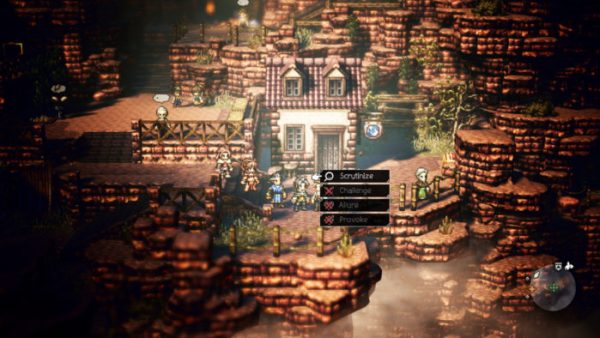
Octopath Traveler’s world is immensely rich, and even after the credits rolled when I beat the eight stories, I was pleasantly surprised to find that there was more to see and do. Some side quests only open up after finishing certain stories, which will offer further insight into the recurring themes you notice across the eight stories, and there are a few optional dungeons and caverns you can explore as well. And if that isn’t enough, the game also has four additional advanced jobs that you can unlock, all of which are locked behind some of the toughest boss fights Octopath Traveler has to offer. These were, without a doubt, the most challenging content I faced in the game, and the rewards were well worth it, as the advanced classes offer you incredible variety and freedom in how you want to build your party. There’s so much to do in the game, and while I was able to complete the story content at around the 68 hour mark, my playtime has since gone up to 75 hours because of everything else there is to do.
And, last but not least, tying everything together into one complete package is the game’s lovely soundtrack and audio design. As impressive as it was for the eight separate stories to all have decent development arcs and proper conclusions, I found it even more impressive that the game was able to boast distinct and unique tracks for all eight characters and all eight regions you get to explore in Orsterra as well. The orchestral performances truly lend a sense of grandeur to the eight journeys; the music rises and falls with every dramatic turn and plot twist, the strings swell with melancholy and just the right amount of dread when you’re in a dungeon, and the game’s main theme is a splendid, sweeping love letter to the JRPGs of yore. It’s rare for the soundtrack to share the spotlight with the narrative and gameplay in video games, but in Octopath Traveler, it steals it at times. Everything just comes together as such a lovely, well-presented package of JRPG goodness.
Octopath Traveler feels like a much more personal collection of tales that might go against what you’d typically expect from a JRPG. More than anything else, the way the characters fall together feels like coincidence rather than providence, and the game is far more concerned with telling intimate stories about grief, friendship, adventure, and redemption. You might not get to save the world, but there’s joy to be had from just helping out someone in a bind and learning more about the deep history of Orsterra as you go. For what it sets out to do, Octopath Traveler excels.
Score: 4.5/5 – Great
Pros
| Cons
|
For more information on how we review games, check out Twinfinite’s review policy here.

